|
SOMETIMES IT GOES THE OTHER WAY TOO
Review: Dodonpachi Dai-Ou-Jou (PS2, Jap import)
It's ironic that possibly the most evolved genre in the modern videogaming world is the one that's probably regarded as the most old-school and "retro". The 2D scrolling shoot-'em-up has been with us for nearly 25 years now, yet while racing games, FPSes and fighting games get narrower and narrower in focus - and harder and harder to tell apart - shmups continue to explore the possibilities of the form and strike out in more and more distinct directions.
Recently the resolutely traditional Raiden 3 received the WoS Game Of 2005 accolade, but it's far from being the only avenue worth travelling for the modern shooter enthusiast. By way of illustration, let's take a close look at the most recent (though admittedly not all that recent - the PS2 version was originally released in Japan in 2003) addition to the four-game Donpachi line from shmup specialists Cave: the ultra-hardcore DoDonPachi Dai-Ou-Jou.
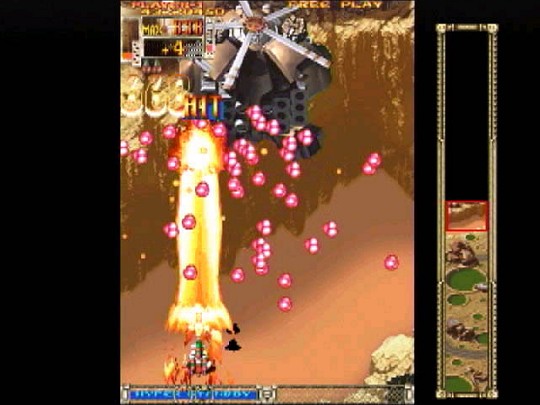
The game offers lots of display options. You can switch the pointless map (right) off, for example.
DDP3, as we'll call it from here on (the series runs Donpachi, Dodonpachi, the controversial non-Cave release Bee Storm: Dodonpachi 2 and then this - the variously-punctuated "Dai-ou-jou" means either "revival" or "peaceful death", depending on which source you believe) is a shmup very much in the "bullet hell" vein. Enemies unload vast geometric cascades of fire at you from almost the word go, filling the screen with hundreds of shots at a time.
Fortunately, as is the way with the genre, your ship isn't nearly as vulnerable to this barrage of death as it would appear - only the tiny area of your fighter plane's cockpit can actually be hit by enemy craft or fire, with the rest able to pass unharmed through the most lethal wall of bullets. It's a formula that allows for spectacular pyrotechnic displays (in the blue-and-pink colourscheme that's become customary in these things), enough to terrify the average would-be player into submission before the demo mode's over, but which experts can see "through" to the safe path that's mathematically mapped out amid the dizzying onslaught.
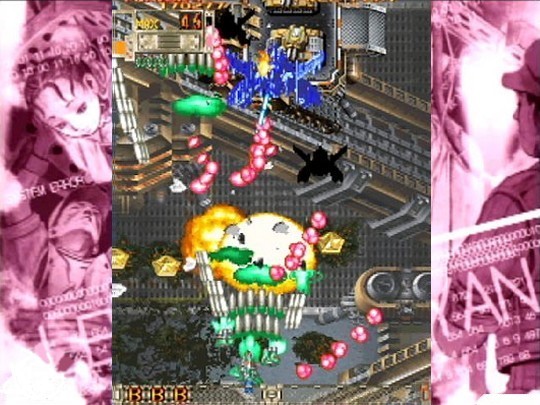
Here we see the map off, and one of the optional "wallpapers" selected. Ick.
As modern shooters divide into two main groupings (the traditional style of Raiden 3 or Gradius V, and the bullet-hell games, pioneered by the likes of Giga Wing), so each grouping is subdivided into many specialised fields, and the instrument of that subdivision is more often than not the scoring system. DDP3's scoring is (thankfully) less complex than many of its peers, and is centred largely around "combos". As long as you can destroy an enemy within about half-a-second of the last one, you'll keep "chaining" the hits. (Strictly speaking, combo chains are based on a charge-meter which doesn't solely react to the destruction of enemies, but in essence that's what it boils down to.) Big chains are the key to big points - good chaining can boost a beginner's Stage 1 score from 1.6 million to 2.4 million, for example.
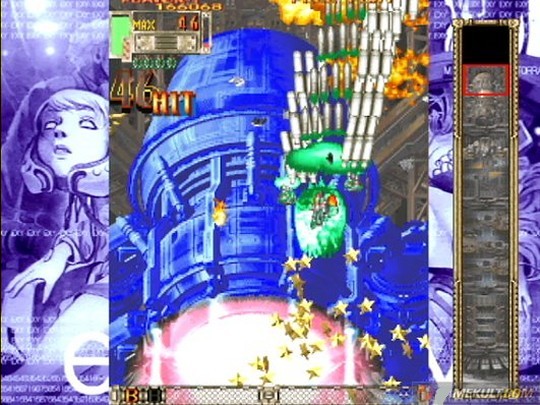
And here we have a different wallpaper, along with the map.
The other common definer of a modern shmup - the weapons system - is very restrained in DDP3. You get just two ships to select from, which are fairly minimally different anyway (the Type A has straight-ahead concentrated fire while the Type B has a wider spread, but for most of the time you'll be using each ship's near-identical secondary beam-lasers), and unlike Raiden
3 there's no way of switching your armament type in play.
You also
choose one of three pilots (the same three for both ships), which
provides the opportunity to trade speed and firepower retention
after death against power and the maximum number of smart bombs that
can be carried. The six permutations therefore available offer the
possibility of a subtle tuning of the player's offensive
capabilities, but no major changes in the way the game is played.
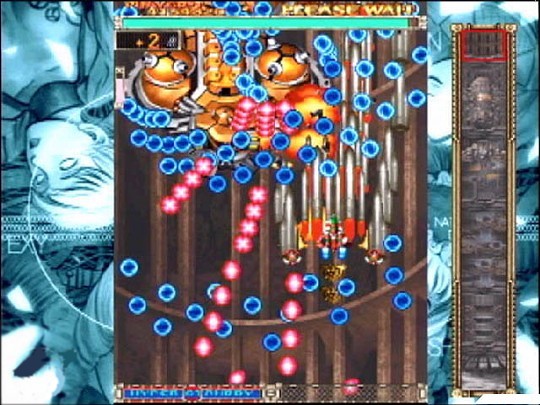
A more subdued wallpaper option here.
So that's you. But what about the bad guys? If you've played any of the other Donpachi
games, you'll know what to expect here - from the very beginning, as
you cross a multi-lane highway lined end to end with tanks, you're
faced with practically a solid wall of enemies, through which you
have to cut a swathe with your powerful weapons. The huge torrents
of bullets also start off early, with a few enemies vaguely aiming
in your direction, but most simply spewing out preset geometric
patterns of fire which instantly fill up large amounts of screen
area with flowering death.
Because DDP3 focuses unusually
strongly on straight-ahead fire, most of the time you'll have to be
trying to sweep methodically across the screen from side to side
with your beam laser, a process that'll leave very little alive in
its wake. The game's main challenge at this stage is to learn its
patterns and get into its rhythm, so that you're always at the
correct side when the next wave of enemies arrives. This both
ensures that they don't get to unleash hundreds of bullets before
you can kill them, and that you're always blowing stuff away in
quick succession to keep your combo counter high.
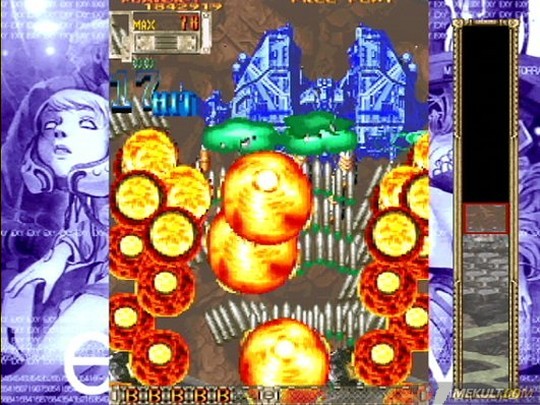
After brief experimentation, you'll almost certainly dispense with the wallpapers.
The first two levels are brutally tough, but manageable. Again unlike Raiden, there are never really any breathing-spaces where nothing's shooting at you and you can blink and relax for a moment and quickly gather your wits (in fairness, the nature of the scoring system needs it to be this way), but there's the occasional moment where the barrage lets up enough to let you get your ship back into the middle of the screen and give yourself some manoeuvring options.
You'll still get plastered initially, but after a little practice and with judicious use of a smart bomb now and again, you'll be able to make it at least as far as the scary second boss on your first credit. Stage 3, however, ramps the difficulty up savagely, and most ordinary players will simply have no chance from there on. Weirdly, and almost uniquely among modern shmups, the enemy onslaught in DDP3 is so incredibly ferocious that after Stage 2, the bosses are in fact the easiest part of the levels, and provide the closest thing on offer to a welcome break.
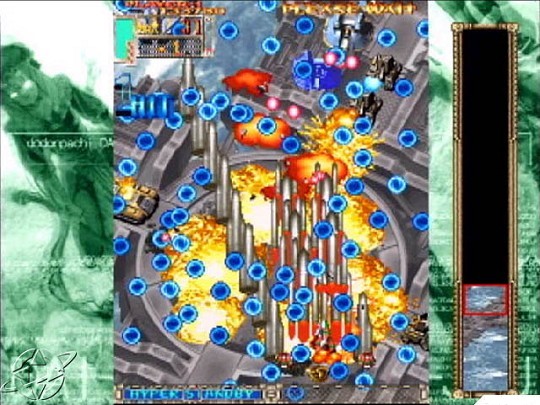
In most cases, whichever one you select, they're just visually distracting.
The sharp difficulty hike on the third level is a standard coin-op trait, of course, and it's here that DDP3 really betrays its arcade roots. There's none of the structural sophistication of Gradius V or Raiden 3 here, no incrementing credits system to reward players for persistence or skill. You're on Free Play from the start, so if you take one look at Stage 3 and think "I'll never beat that",
you can just use the infinite continues to buy your way right to the
end of the game, in which case the whole thing will be over 20
minutes after you took the plastic wrapping off the box.
It's odd
that, with such a tried-and-tested system available for extending
the play life of this type of game, so many choose not to bother
with it, and invariably suffer in reviews as a result. It's easy to
say that players should just have the discipline to resist using
infinite credits, but when the difficulty is this forbidding it's
hardly a surprise that most people aren't prepared to even try to
achieve the superhuman skill required to do things the hard way.
DDP3 doesn't even offer a traditional Score Attack mode in
compensation (there is a fantastically complex, deeply customisable
"Simulation Mode" which performs a similar task, but in a terribly
convoluted and unfocused way), and the general impression the game
gives is that it isn't the least bit interested in appealing to
anyone but the most diehard shooter buffs.
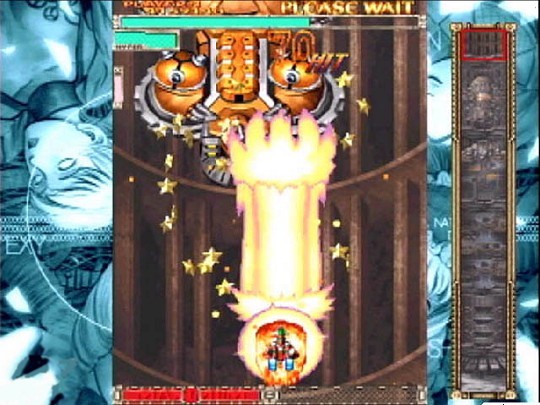
This, incidentally, depicts the Hyper Laser powerup at work. It's not as useful as it looks.
The sad thing is, of course, that it's different to see what DDP3 could lose by making itself a little more accessible. The shmup ultra-fanboys sneer at using more than one credit to finish these games anyway, so a limited-but-incrementing credits system wouldn't upset them any. Having to earn a glimpse at the later levels rather than blithely continuing through them is going to encourage less hardcore players to play shmups properly, increasing the chances of them developing a liking for the genre and therefore buying more shmups in the future.
And for wusses who just want to see all the graphics they've paid for, there's always No Bullets mode. This is a feature DDP3 does share with Raiden 3, and seems to be a fairly new and interesting innovation in the field. No Bullets mode does exactly what it says - takes you through the whole game, with all the scenery and enemies of the normal mode, but with the crucial difference that none of the baddies are allowed to shoot at you. Which is a really novel idea, and useful if you just want to learn where enemies are going to appear and practice maximising your combo scores, but if you think about it is a rather morally-dubious notion - in No Bullets mode, DDP3 is less a shmup, more a genocidal warcrimes simulator.
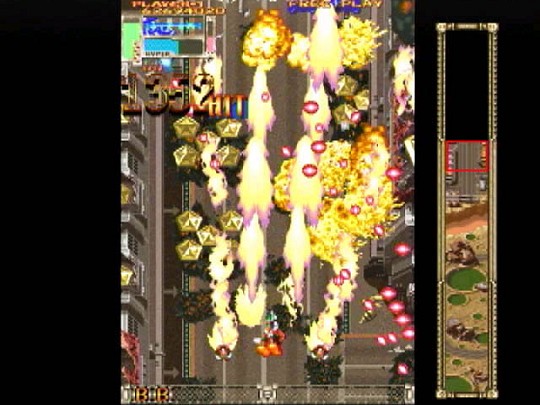
As you can see, there's plenty going on onscreen without complicating it with backdrops.
And so concludes our brief look at just one of the many directions the shmup has evolved in over the last few years. Notionally, to the casual eye, Dodonpachi Dai-Ou-Jou and Raiden 3 are in essence the same game, but they're really as different as Outrun 2 and Gran Turismo 4, which both merely happen to be loosely about cars.
There's a whole wide world of incredible variation within the genre, which is largely done a great disservice by the gaming media, and the fact that publishers like Sony actively try to prevent games like this being brought to the West is criminal. Sadly, DDP3 isn't one of the shmups that either has had or is about to have a budget-priced Western release, but there are (belatedly) enough out there now for even total novices to investigate the treasures of this mostly-ignored gaming niche.
Try Psyvariar, try XII Stag, try R-Type Final (widely available in bargain bins and secondhand shelves nationwide - your reporter saw it in his local MVC for £4.99 brand new this week), try (obviously) Gradius V, try Mobile Light Force 2 (aka Shikigami no Shiro), try Castle Of Shikigami 2, and try Raiden 3 and Giga Wing Generations and Dragon Blaze and Homura when they come out here in a few weeks. None of them should set you back more than a tenner or so.
(Don't try the PAL releases of Strikers 1945, Gunbird
2 or Steel Dragon Ex, which are crippled by either the unforgivable
lack of high-score saving or, in the latter case, the sort of
appalling 50Hz bordered PAL conversion we all hoped we'd seen the
last of in about 1996.)
Every one
of them - and even flawed games like DDP3 - will bring you the sort
of breathless, old-school adrenaline rush that made you like
videogames in the first place but thought they didn't do any more.
But beyond that initial thrill, they'll also pay back every minute
of effort you invest in them, in spades.
Or, y'know, just buy 50 Cent: Bulletproof, and damn us all to Hell.
|

